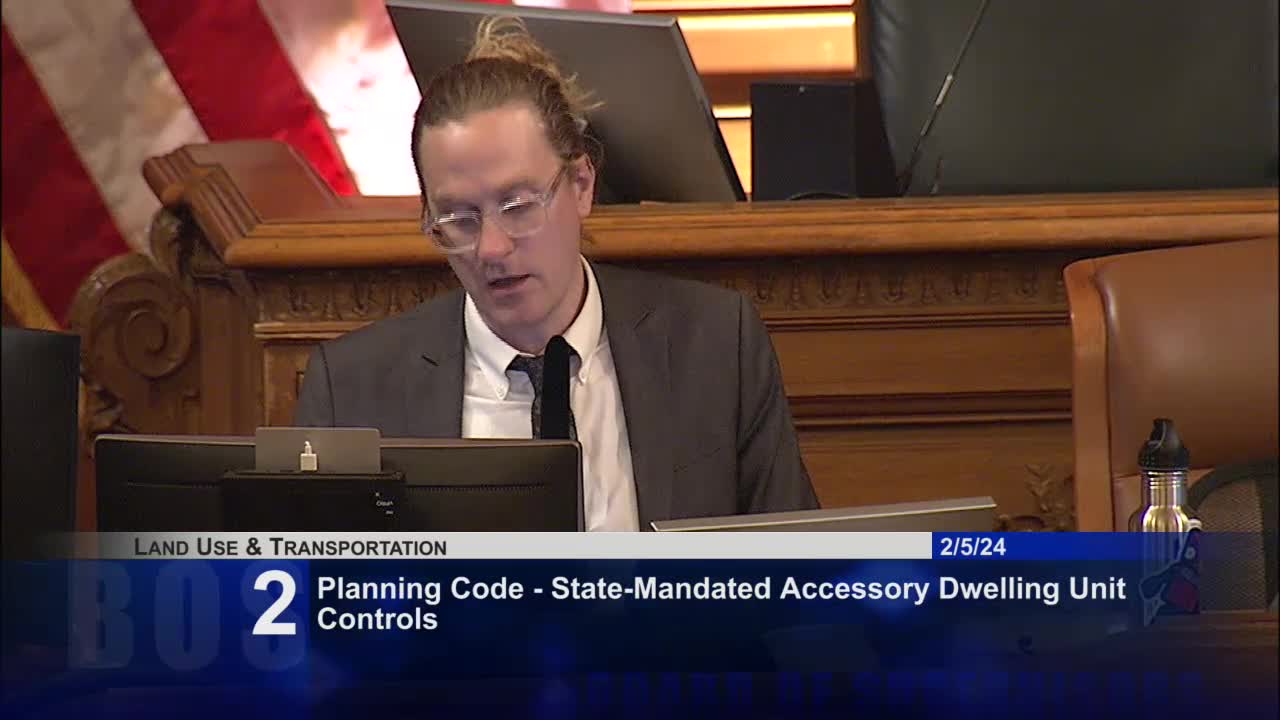Supervisor Dorsey sponsors fee waiver ordinance for downtown rail extension projects
February 05, 2024 | San Francisco County, California

This article was created by AI summarizing key points discussed. AI makes mistakes, so for full details and context, please refer to the video of the full meeting. Please report any errors so we can fix them. Report an error »

In the heart of San Francisco's bustling city hall, a pivotal discussion unfolded as city officials gathered to address the future of housing and infrastructure along the downtown rail extension corridor. The meeting, held on July 4, 2025, centered around an ordinance aimed at amending the planning code to conditionally waive certain fees for development projects in this crucial area.
Madison Tam, representing Supervisor Dorsey, introduced the legislation, highlighting the collaborative efforts between the city, the Transbay Joint Powers Authority (TJPA), and developer Tishman Speyer. "This is a win-win for everyone," Tam stated, emphasizing the ordinance's role in supporting ambitious housing goals, particularly in the Central SoMa neighborhood.
The proposed ordinance seeks to amend section 406 of the planning code, allowing for the conditional waiver or reduction of transportation sustainability fees and Eastern neighborhoods infrastructure impact fees for projects along the downtown rail extension, also known as the portal. This initiative aims to stimulate development by easing financial burdens on builders, thereby facilitating the construction of stalled projects.
Monica Giacomucci from the Planning Department provided an overview of the ordinance, noting that the Planning Commission had already recommended its approval. The commission found that the proposed fee waivers are reasonable, as they align with the overarching goals of improving transit options and supporting infrastructure development in the city.
A key aspect of the ordinance is the requirement for project sponsors to enter into agreements with the TJPA to select enhanced foundation types that mitigate impacts on the downtown extension tunnel. If the costs of these specialized foundations exceed those of standard options, projects could qualify for significant fee waivers, thus encouraging developers to proceed with their plans.
One notable project mentioned during the meeting is located at 655 Fourth Street, directly above the portal and poised to add 105 new dwelling units to the city’s housing stock. This project, which received Planning Commission approval in December 2023, exemplifies the type of development that could benefit from the proposed ordinance.
As the meeting concluded, the implications of this legislation became clear: it not only aims to alleviate financial barriers for developers but also seeks to enhance the city’s housing landscape and infrastructure. With the ordinance poised for further consideration, San Francisco stands at a crossroads, balancing the need for growth with the challenges of urban development.
Madison Tam, representing Supervisor Dorsey, introduced the legislation, highlighting the collaborative efforts between the city, the Transbay Joint Powers Authority (TJPA), and developer Tishman Speyer. "This is a win-win for everyone," Tam stated, emphasizing the ordinance's role in supporting ambitious housing goals, particularly in the Central SoMa neighborhood.
The proposed ordinance seeks to amend section 406 of the planning code, allowing for the conditional waiver or reduction of transportation sustainability fees and Eastern neighborhoods infrastructure impact fees for projects along the downtown rail extension, also known as the portal. This initiative aims to stimulate development by easing financial burdens on builders, thereby facilitating the construction of stalled projects.
Monica Giacomucci from the Planning Department provided an overview of the ordinance, noting that the Planning Commission had already recommended its approval. The commission found that the proposed fee waivers are reasonable, as they align with the overarching goals of improving transit options and supporting infrastructure development in the city.
A key aspect of the ordinance is the requirement for project sponsors to enter into agreements with the TJPA to select enhanced foundation types that mitigate impacts on the downtown extension tunnel. If the costs of these specialized foundations exceed those of standard options, projects could qualify for significant fee waivers, thus encouraging developers to proceed with their plans.
One notable project mentioned during the meeting is located at 655 Fourth Street, directly above the portal and poised to add 105 new dwelling units to the city’s housing stock. This project, which received Planning Commission approval in December 2023, exemplifies the type of development that could benefit from the proposed ordinance.
As the meeting concluded, the implications of this legislation became clear: it not only aims to alleviate financial barriers for developers but also seeks to enhance the city’s housing landscape and infrastructure. With the ordinance poised for further consideration, San Francisco stands at a crossroads, balancing the need for growth with the challenges of urban development.
View full meeting
This article is based on a recent meeting—watch the full video and explore the complete transcript for deeper insights into the discussion.
View full meeting
